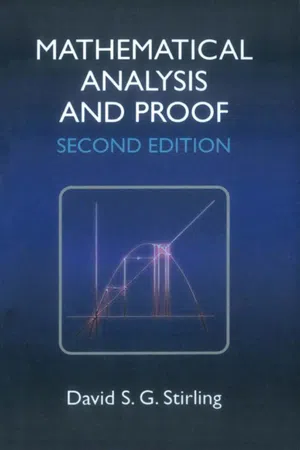Mathematics
Injective functions
Injective functions are mathematical functions that map each element of the domain to a unique element in the range. This means that no two elements in the domain are mapped to the same element in the range. Injective functions are also known as one-to-one functions.
Written by Perlego with AI-assistance
Related key terms
Related key terms
1 of 4
Related key terms
1 of 3
5 Key excerpts on "Injective functions"
- eBook - ePub
- David S G Stirling(Author)
- 2009(Publication Date)
- Woodhead Publishing(Publisher)
f : A → B . Then we say that g : B → A is the inverse function to f if ∀x ∈ A g (f (x )) = x and ∀y ∈ B f ((g(y )) = y . If such an inverse function g exists, we denote it by f − 1 (not to be confused with 1/f ).The function f : A → B is said to be injective if distinct points in A have distinct images under f . In symbols this is ∀x 1 , x 2 ∈ A x 1 ≠ x 2 ⇒ f (x 1 ) ≠ f (x 2 ) (or equivalently, f (x 1 ) = f (x 2 ) ⇒ x 1 = x 2 ). f is said to be bijective if it is injective and every point in B is the image of some point in A . (In symbols, the second condition is ∀y ∈ B ∃x ∈ A such that y = f (x ).) A bijective function f : A → B establishes a correspondence between the members of the sets A and B in that every x ∈ A is mapped by f to one member f (x ) ∈ B and every member y ∈ B is of the form f (x ) for exactly one x ∈ A .Example 10.8 Let f 1 : [0, ∞) → [0, ∞) be given by f 1 (x ) = x 2 and g 1 : [0, ∞) → [0, ∞) be given by g 1 (x ) = √x . Then g 1 = f 1 − 1 . Notice also that f 1 , is injective, while f 2 : → [0, ∞) given by f 2 (x ) = x 2 is not injective because f 2 (1) = f 2 (–1). Mark this example: the domain of the function is as important as the rule for transforming x to f (x ).We are interested in conditions which guarantee the existence of an inverse function. We first notice that if f has an inverse (g say) then f is injective, for, in the notation of the definition, f (x 1 ) = f (x 2 ) ⇒ g (f (x 1 )) = g (f (x 2 )) ⇒ x 1 = x 2 . The second point is that if f : A → B is to have an inverse then every point of B must be in the image of f (since y = f (g (y )) in the above notation). In practice, we often pay less attention to the codomain so we may be prepared to alter it. Let f (A ) denote the image of f , that is, the set {y ∈ B: ∃x ∈ A s.t. y = f (x )} (or, more briefly, {f (x ): x ∈ A }) where f : A → B . Then if f is injective, we see that for all y ∈ f (A ) there is an x ∈ A satisfying f (x ) = y and, since f is injective, there is only one such x . Define g (y ) to be x . Then g : f (A ) → A and it is easily checked that g is the inverse of f - eBook - ePub
Introduction to Differential Calculus
Systematic Studies with Engineering Applications for Beginners
- Ulrich L. Rohde, G. C. Jain, Ajay K. Poddar, A. K. Ghosh(Authors)
- 2012(Publication Date)
- Wiley(Publisher)
onto function as discussed below in (A) and (C), respectively.A. One–One Function : A function is one-one provided distinct elements of the domain are related to distinct element of the codomain . In other words, a function f : A → B is defined to be one-one if the images of distinct element of A under f are distinct, that is, for every a 1 , a 2 A , f (a 1 ) = f (a 2 ) ⇒ a 1 = a 2 . [It also means that, f (a 1 ) ≠ f (a 2 ) ⇒ a 1 ≠ a 2 .] A one–one function is also called injective function (Figure 2.7a and b ).Figure 2.7Note: If there is at least one pair of distinct elements, a 1 , a 2 A , such thatthen, such a function is called many–one . We define many-one function as follows:B. Many–One Function : If the codomain of the function has at least one element, which is the image for two or more elements of the domain, then the function is said to be many–one function (Figure 2.8a and b ).Figure 2.8A constant function is a special case of many–one function (Figure 2.9 ).C. Onto Function : A function f : A → B is called an onto function if each element of the codomain is involved in the relation .Figure 2.9Figure 2.10Figure 2.11(Here, range of f = codomain B .)In other words, a function f : A → B is said to be onto if every element of B is the image of some element of A , under f , that is, for every b B , there exist an element a A such that f (a ) = b (Figure 2.10a and b ). Onto function is also called surjective function .The most important functions are those which are both one–one and onto . In a function that is one–one and onto, each image corresponds to exactly one element of the domain - eBook - ePub
- Bhavanari Satyanarayana, T.V. Pradeep Kumar, Shaik Mohiddin Shaw(Authors)
- 2019(Publication Date)
- CRC Press(Publisher)
(6.1) , we get thatf=(x + 3)− 3(2x + 3)(+ 2x + 3)=x 2+ 6 x + 9 − 3 x − 9 + 2=x 2+ 3 x + 26.2 Types of Functions (including Bijective Functions)
Definition(i) f : S → T is said to be one-one function (or injective function) if it satisfies the following condition:f(= fs 1)(⇒s 2)s 1=s 2.(ii) f: S → T is said to be onto function (or surjective function) if it satisfies the following condition:t ∈ T ⇒ there corresponds an element s in S such that f(s) = t.(iii) A function is said to be a bijection if it is both one-one and onto.Example 6.6(i) f: R → R such that f(x) = 3x + 2 is an one-to-one and onto function.(ii) f: N →{0, 1} such thatfis an onto function but not an one-one function.( x )={1 ,if x is odd0 ,if x is even(iii) f: N → N defined by f(x) = x2 + 2. It is an one-one function not an onto function, since there is no x ∈ N such that f(x) = 1.(iv) f: R → R be such that f(x) = | x | where | x | is the absolute value of x. Then f is neither one-one nor onto.Theorem 1Let X and Y be two finite set with same number of elements. A function f: X → Y is one-to-one if and may is it is onto.Proof: Let X = {x1 , x2 , …, xn } and Y = {y1 , y2 , …, yn }. If f is one-to-one then {f(x1 ), f(x2 ), …, f(xn )} is a set of n distinct elements of Y and hence f is onto.If f is onto then {f(x1 ), f(x2 ),…, f(xn )} form the entire set Y, so must all be different. Hence f is one-to-one.From the above theorem, we can understand that if we have a bijection between two finite sets, then the two sets must have same number of elements.6.2.1 Observation
Example 6.7The function σ : Z+ → Z+ - eBook - ePub
Elementary Point-Set Topology
A Transition to Advanced Mathematics
- Andre L. Yandl, Adam Bowers, Adam Bowers(Authors)
- 2016(Publication Date)
- Dover Publications(Publisher)
Y .Let f : X → Y be a function. If A ⊆ X is a subset of the domain of f, then the image of A is denoted f(A) and is defined to be the setIf B ⊆ Y is a subset of the codomain of f, then the inverse image (or preimage) of B is denoted f–1 (B) and is defined to be the setIt is important to note that the notation f–1 (B) does not imply that the inverse function f–1 is defined, because f may not be one-to-one.It is common in the literature to see other terms for functions that are onto or one-to-one. A function that is onto is sometimes called a surjection, a function that is one-to-one is also known as an injection, and a function that is both an injection and a surjection is called a bijection. Such functions are said to be surjective, injective, and bijective, respectively.Example 3.1.1. Let be the set of real numbers and define a function f : → by f(x) = x2 for x ∈ .(a) Show that f is neither onto nor one-to-one.(b) Find f ({−3, −1, 2, 4}), the image of the set {−3,−1, 2, 4}.(c) Find the preimages: f–1 ([4, 9]), f–1 ([–1, 9]) and f–1 ([–4, –1])Solution. (a) The range of f is contained in the interval [0, ∞) because x2 ≥ 0 for all real numbers x. Since [0, ∞) is a proper subset of , the function f is not onto. To see that the range of f is [0, ∞), simply observe that if x ≥ 0, then and . Finally, note that f is not one-to-one because f(–2) = 4 = f(2), but –2 ≠ 2.(b) By definition,(c) We use the definition of the preimage:Notice that the last preimage is the empty set because x2 ≥ 0 for all x ∈ .Example 3.1.2. Let be the set of real numbers and define a function g : → by g(x) = 3x + 2 for x ∈ .(a) Show that g is onto and one-to-one.(b) Find a formula for g–1 (x).Solution. (a) Let c ∈ . Solve the equation 3x + 2 = c for x and get . Becauseit follows that g is onto. To see that g is one-to-one, observe that(b) In (a), we showed g was one-to-one and onto. Consequently, the inverse function g–1 exists and for each x ∈ , we have g(g–1 (x)) = x - eBook - ePub
- Valentin Deaconu(Author)
- 2016(Publication Date)
- Chapman and Hall/CRC(Publisher)
4Functions
Many times we deal with quantities which depend on other quantities: the volume depends on the size, the heat index depends on the humidity, the force depends on the mass. These illustrate the idea of a function. In mathematics, a function is a certain rule which associates to any element in a set A , called the domain, a unique element in a set B , called the codomain. You already met real functions of real variables in calculus, like f (x ) = x 2 , g (x ) = ln x or h (x ) = tan x . The domain and the set of values for these functions are subsets of ℝ, and a function is defined as a formula (or algorithm) which associates to each input in the domain a precise output. The domain of f is ℝ and the set of values is [0, ∞). The domain of g is (0, ∞) and the set of values is ℝ. The domain of h isR \ {and the set of values is ℝ. We will need to work with more general functions among all kinds of sets, not just subsets of the real numbers.( 2 k + 1 )}π 2: k ∈ ZEven though a function is a particular case of a relation, we study functions first and define relations in the next chapter. After giving the precise definition of a function using its graph, we introduce operations and give several examples of functions. A given function determines two new functions, called the direct image and the inverse image, where the inputs and the outputs are sets. Sometimes it is necessary to shrink or enlarge the domain of a function, giving rise to restrictions and extensions. We also discuss one-to-one and onto functions, composition, and inverse functions. We conclude with families of sets and the axiom of choice, necessary in many proofs.
Index pages curate the most relevant extracts from our library of academic textbooks. They’ve been created using an in-house natural language model (NLM), each adding context and meaning to key research topics.
Explore more topic indexes
Explore more topic indexes
1 of 6
Explore more topic indexes
1 of 4




